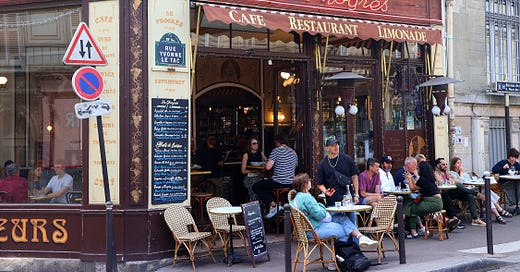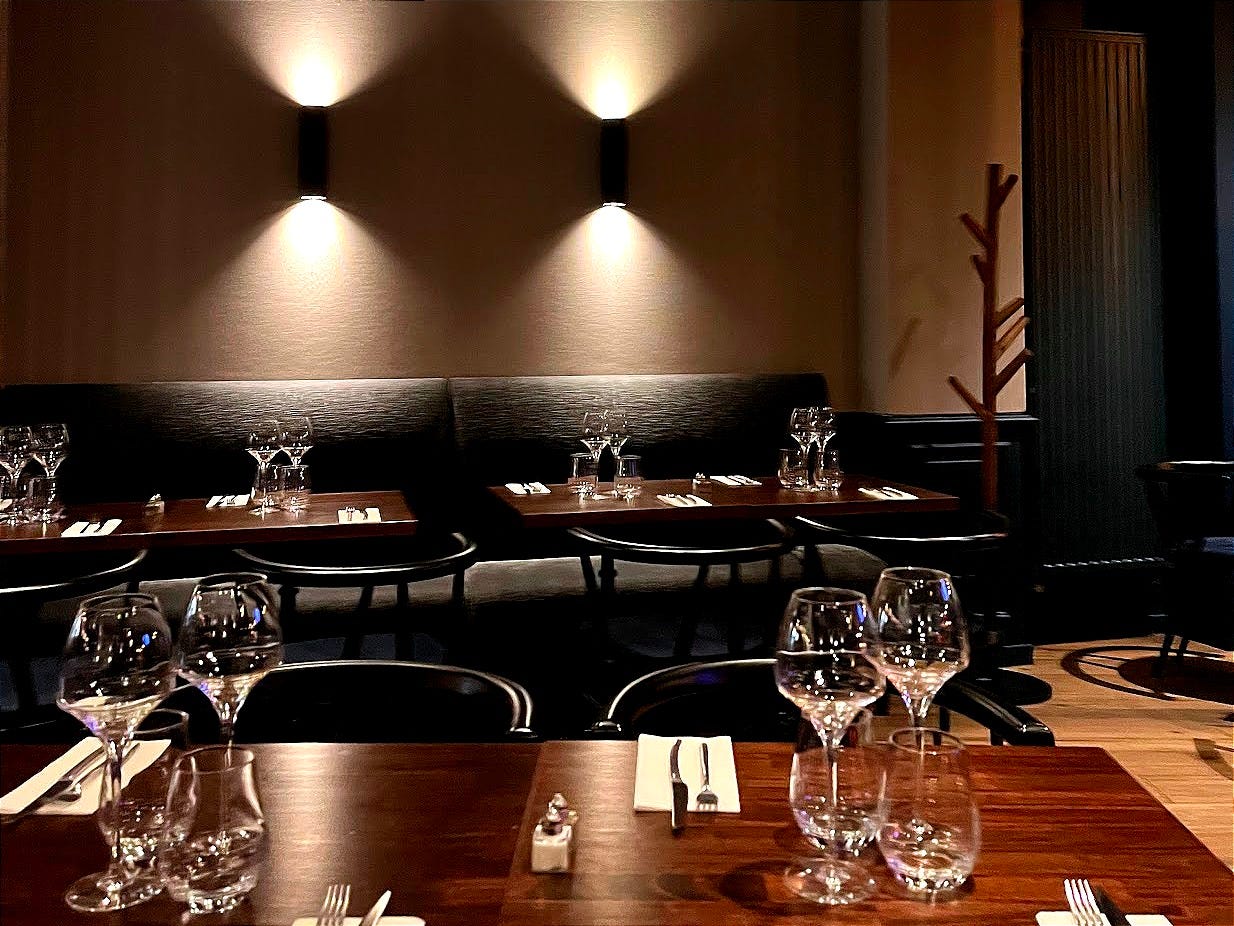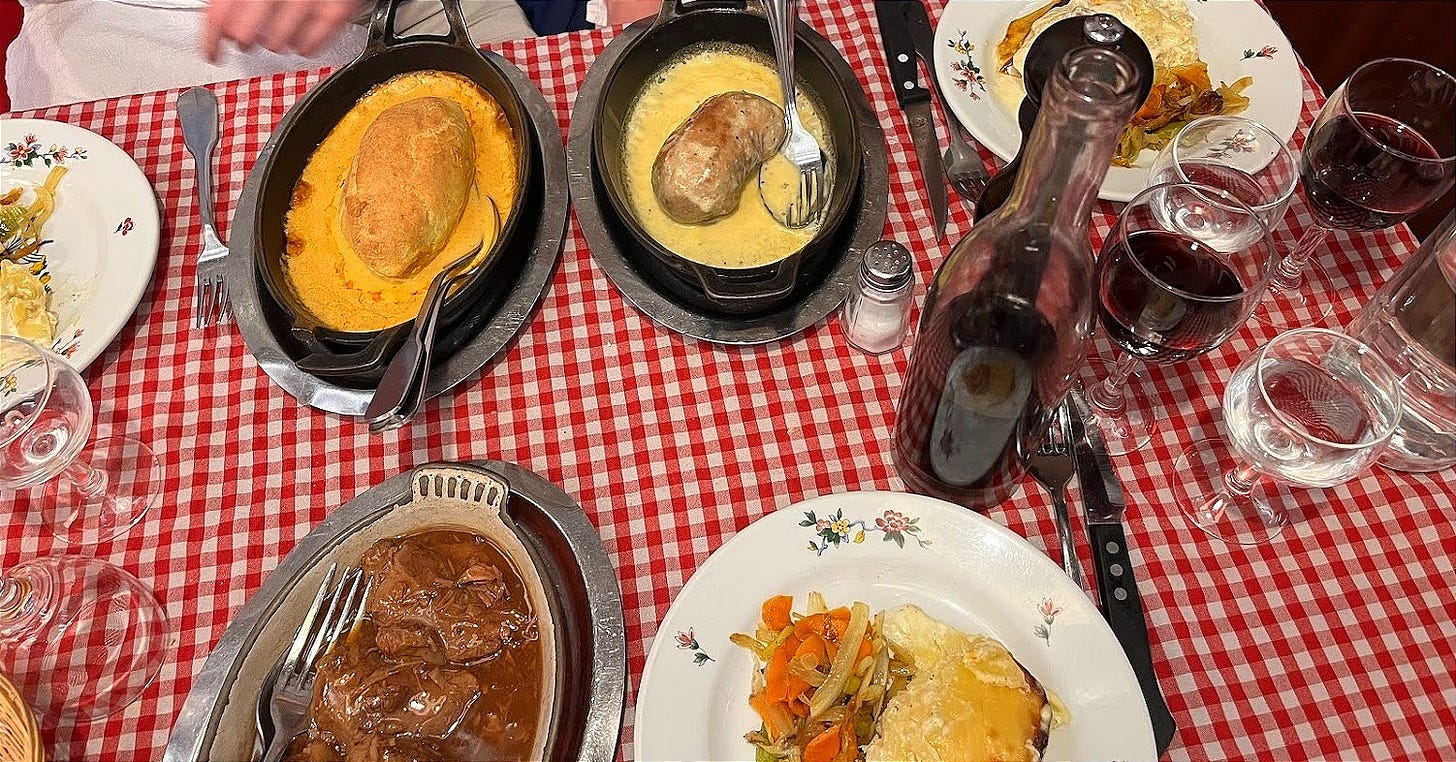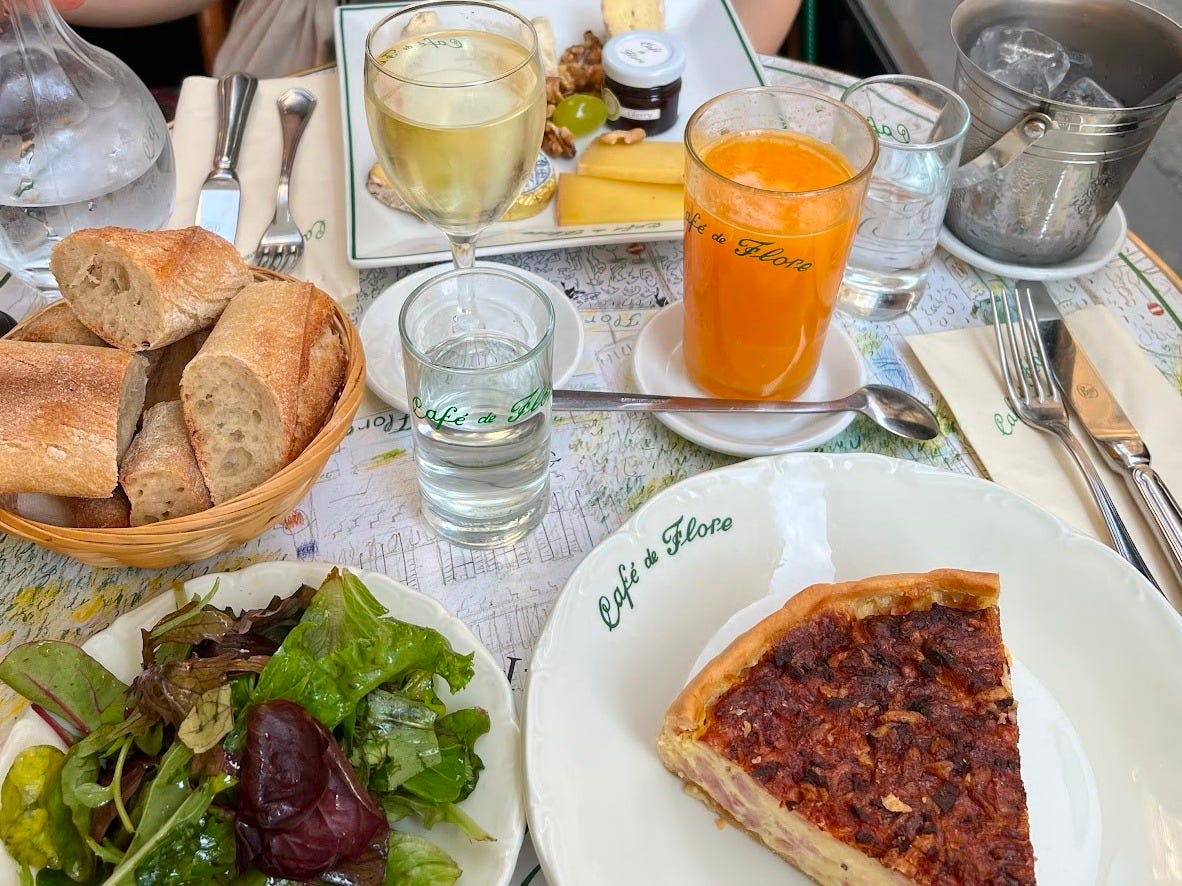There’s certainly no shortage of restaurants in France. Almost every street seems to be lined with endless terraces, venues buzzing from 7am until midnight, with some already packed by 11am. Whether catering to locals, tourists, celebrities, artists, couples, or families, you’ll find eateries of every size, offering something for everyone. But with so many options, it can be tricky to decipher what kind of restaurant you’re walking into. Is it a brasserie? A bistro? A bouillon? And what are cafés? Do they even serve coffee and croissants, or is that a boulangerie? What is the etiquette? What can you expect?
» Brasseries
Brasseries are the quintessential Parisian dining experience (although you can find them all over France). Picture straw chairs, round tables spilling onto the sidewalk, waiters in black waistcoats carrying trays, and a lively, bustling atmosphere. You can pop in for just a drink, or a full meal. The menu is available all day long, with service continu (continuous table-side service). In Reims, the capital of the Champagne region, it was common to see people drop by for a glass of bubbles or beer accompanied by a bowl of frites—whether solo or with friends. If you’re feeling hungrier, you can opt for the formule (a set menu with entrée, main, and dessert at a reasonable price) or choose à la carte. The menu, despite being predictable, will have a range of options, which is part of the charm: simple and classic French dishes, served quickly. The service? Efficient, if not overly formal. Waiters may be a bit brisk when it’s busy, using their fingers to carry as many glasses as possible, or stacking plates into precarious towers, but in quieter moments they’ll stay to chat.
» Bouillons
On the larger end of the scale, we have bouillons. First opened in the mid-1850s, these spacious establishments were designed to quickly and cheaply feed the masses of blue-collar workers in the city centre. The term “bouillon” is the name for broths that once formed the foundation of the menu. With their stunning décor from La Belle Époque, stepping into a bouillon is like walking into history. In the 20th century, nearly 250 bouillons could be found in the city.
One of the most famous is the Bouillon Chartier. Established in 1896, this Parisian icon still serves up dishes for as little as 1 €. Now recognised as a Monument historique (a national heritage site), the experience here is an unforgettable blend of old-world allure and affordability. The waitstaff, known as garçons, wear numbered tags and move with efficiency and banter. To our surprise, we were seated at a table for four, despite there being only the two of us. It didn’t take long to realise this was standard practice — maximising space by sharing larger tables with other guests. Looks like you’ll be getting to know your neighbours! As for the ordering process, forget about notepads or tablets. Here, the waitstaff jot down your order directly on the paper tablecloth, with handwriting that rivals a doctor’s for its remarkable illegibility.
» Bistro(t)s
Smaller and more intimate than a brasserie, bistros offer a cosy dining experience with moderate prices and portions to match. You’ll often find them tucked away in side streets, while brasseries dominate the larger boulevards. Bistros are open during specific mealtimes (12:00–14:30 and 19:00–23:00), making them ideal for a casual lunch or dinner with friends or family.
» Bistronomique
If you’re after something more modern and creative, step into the world bistronomique. This fusion of bistro and gastronomy offers inventive takes on French cuisine at a slightly higher price point—around €40 to €50 for the formule. Expect more sophistically plated dishes, perhaps an open kitchen, and a menu that’s sure to impress your Instagram followers. Bistronomique bridges the gap between casual dining and Michelin-starred restaurants, offering refined meals without the hefty price tag.
» Bouchon
Lyon, of course, has its own take on the bistro with the bouchon. These cosy, often family-run establishments serve hearty, traditional Lyonnaise dishes in a more rustic setting. I’ve already written about my favourite bouchon in this post:
» Cafés
Cafés (especially café-restaurants) in France are a bit different from those in English-speaking countries. While I might head to a Melbourne café for avocado toast or a latte to go, French cafés are usually designed for sitting down and socialising. Here, you’ll find sandwiches, the famous croque-monsieur, salades, quiche lorraine, cheese platters, freshly-squeezed orange juice, and a range of other beverages (including a large wine list). There are many famous cafés in Paris, especially in the Latin Quarter, where prominent philosophers, writers, artists, and filmmakers could be found throughout the 19th century. The likes of Picasso, Hemingway, Sartre, and Beauvoir frequented establishments like Le Café de Flore, Les Deux Magots, or Le Café de la Paix. These mythic institutions are absolutely worthy of a visit, and were our first stop after getting off the plane. Just don’t try to order a latte for takeaway.
If what you’re looking for is simply a coffee and cookie to go, a torrefacteur (coffee roaster) is your best bet for high quality, barista-made drinks. LOUTSA is one of my favourites. Alternatively, although Cafés will often serve a small selection of baked goods and pastries, artisan boulangeries are your go-to for all things bread (croissants, pain au chocolat, pain suisse…) and pâtisseries for all your sweet cravings (tarte au citron, gâteaux, éclair…).
I’ve often wondered why Australia doesn’t have a true equivalent to the French brasserie. The closest thing might be a pub, but there’s a stark difference in atmosphere. Pub staff are more likely to be in scruffy T-shirts than slick black waistcoats, and the setting is much more functional than ornate. There’s a casualness that doesn’t quite match the elegance of a French brasserie, where chandeliers hang above red leather banquettes and waiters might flambé a Crêpe Suzette tableside. In an Aussie pub, you’d be lucky if they even pour your wine at the table.
This fascinating blend of bustling brasseries, quaint bistros, historic bouillons, and lively cafés make France’s dining scene truly unique and unforgettable. From early morning to late at night, in the heart of major cities or tucked away in small towns, you'll find places that take immense pride in serving delicious food. While they might not bring the refined service or culinary creativity I often praise in Michelin-starred venues, they certainly have their own charm — something that will undoubtedly keep me coming back again and again.











Thanks for sharing, Sean.
There's another famous type of restaurants that is less known and hardly gets any attention at the moment: Les Relais Routiers.
Created in 1934 to allow truck drivers to take a break and read the newspaper, over 4000 restaurants received the red and blue "Les Routiers" quality label by the late 50'. As tourism grew in the 60' they became the preferred restaurant stop for many vacationers driving south with their families. Most of them served local specialties at a very low price, served quickly.
They are still around, mostly on the "routes nationales" and continue to essentially serve road warriors. Expect to find large parking lots filled with trucks, vans, and cars of sales representatives. They are all low-key and serve basic meals cooked well at low prices.
Far better than the industrialized meals served at the motorway restaurants, cheaper, and definitely more interesting...
Great article. This French native enjoyed this handy and accurate overview of some of France’s eateries and will be sharing it with her community. Merci Sean!